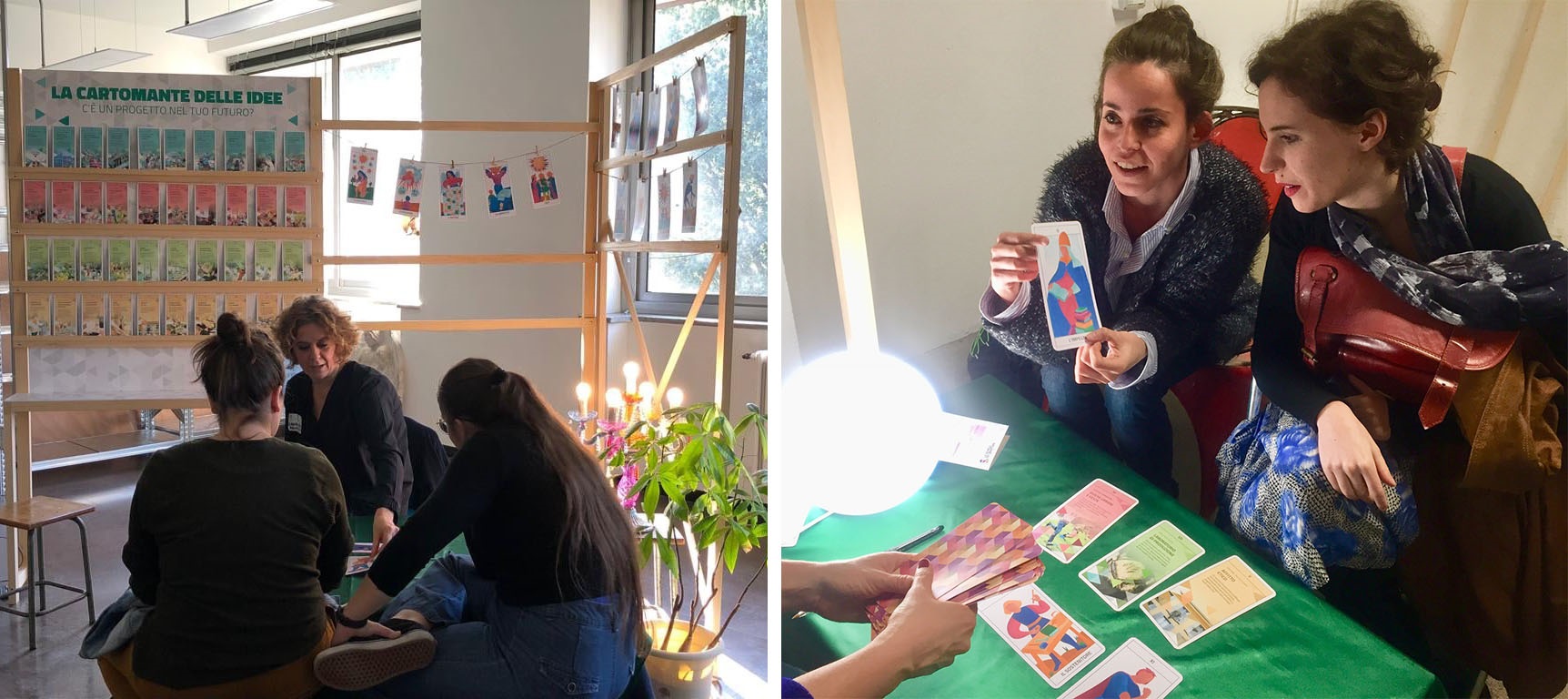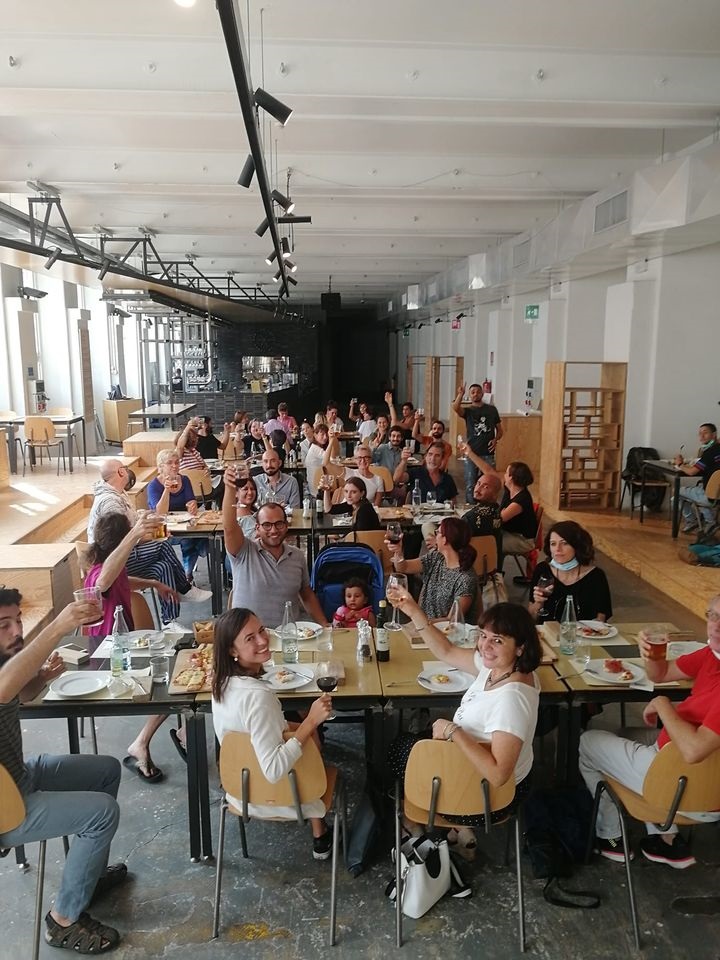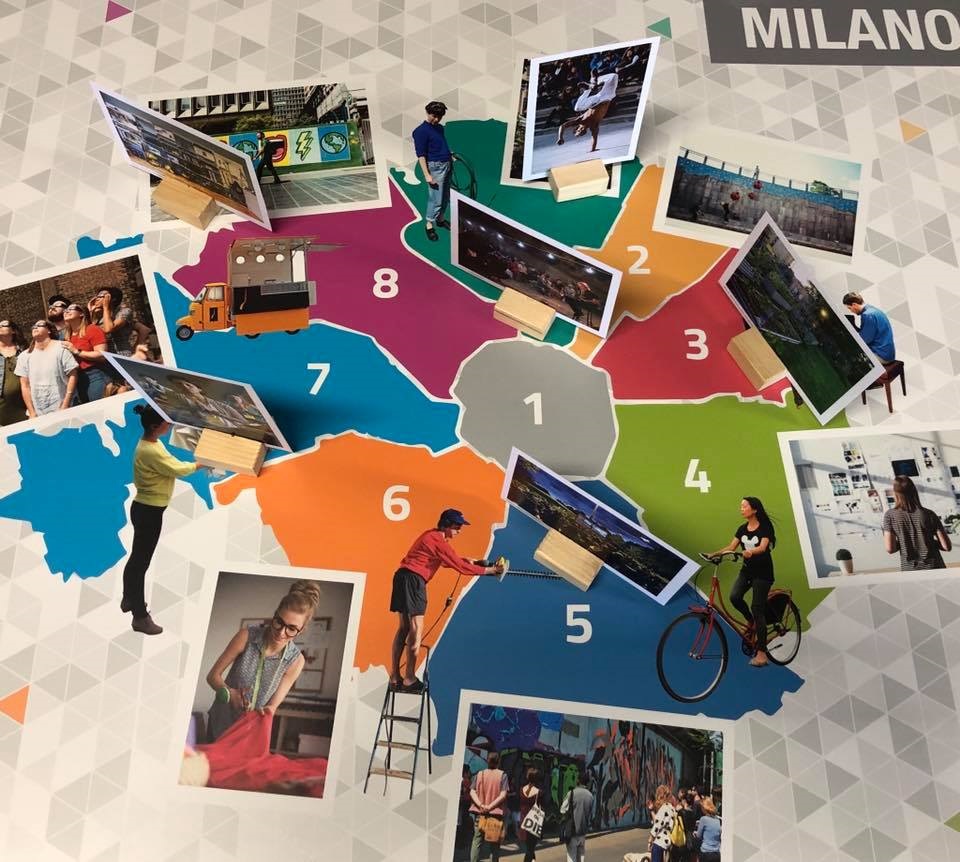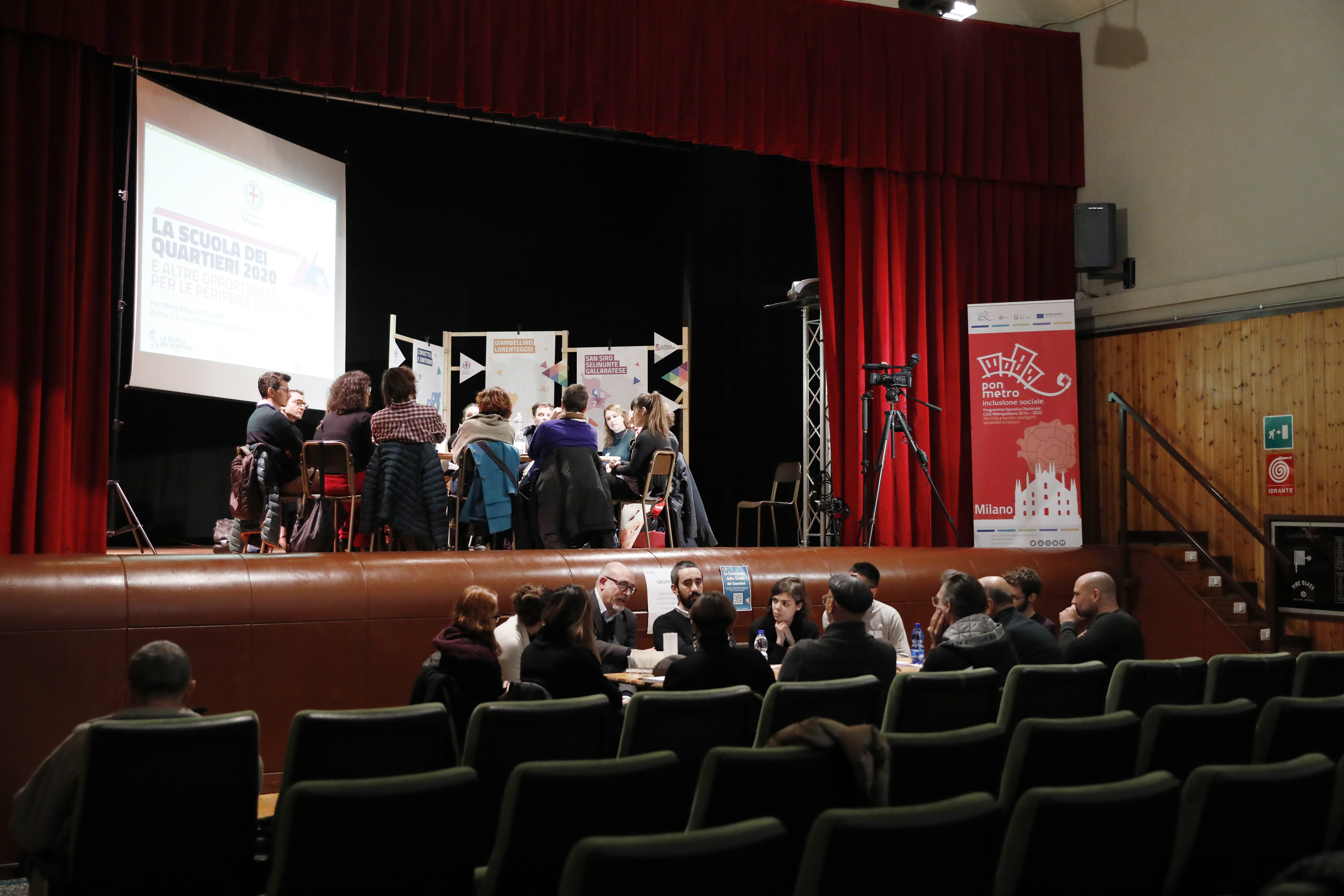The School of the Neighbourhoods (‘Scuola dei Quartieri -SdQ) is a free school of social innovation and entrepreneurship open to all citizens and spread throughout the city.
Conceived as a capability-building programme continuing the tradition of Milan's "civic schools", it contributes to the transformation of disadvantaged neighborhoods, spreading the ability and aptitudes of the inhabitants to design social impact solutions that respond to the needs of local communities.
National Operational Programme Metropolitan Cities 2014- 2020; Thematic Objective (TO) 9: Social Inclusion
The School of Neighbourhoods (“La Scuola dei Quartieri”, from now on ‘The SdQ’) is a project promoted by the Municipality of Milan, which aims to create new activities and services, designed and implemented by citizens, to improve the life in the suburban areas.
Conceived as a capability-building multidisciplinary program open to all citizens and extended throughout the city, the SdQ continues the tradition of Milan's "civic schools" transmitting knowledge and practical tools to transform ideas, needs and desires into concrete, lasting and sustainable projects. The topics of intervention can be the most diverse such as: care activities, commercial and craft activities with a social impact, mutual aid projects, social gathering spaces, artistic and cultural promotion activities, circular economy and environmental protection, sports and well-being, training and education activities, etc.
Without classrooms, the SdQ takes place where people live and work (social spaces, public places, offices, backrooms, etc.). It is organised in cycles of scouting and incubation, each one of 3 phases:
- Public calls open to groups of minimum 2 citizens who are invited to submit innovative, useful and sustainable project ideas;
- Economic contributions, i.e. a grants up to € 25,000 aimed at supporting the first-year implementation of each selected ideas though the creation of new high impact non-profit organizations (association, social enterprise, etc);
- Training courses and customized supporting services throughout the whole project duration.
The SdQ is co-financed by the European Union under the National Operational Programme Metropolitan Cities 2014-2020, and it is implemented by a consortium of organizations specialized in the fields of social economy and innovation design. Information and materials, including a description of the winning projects, are available on the website: https://lascuoladeiquartieri.it.
Please highlight how the project can be exemplary in this context
The SdQ is inspired by the tradition of the Milanese Civic Schools, which are educational institutions promoted by Milan Municipality with the aims of training people in sectors related to the craftmanship and the arts. They represent – we could say – the “Milan way” to the Bauhaus, a pragmatic approach to give people opportunities in the labour market, to be self-sufficient, strengthen self-expression skills and to participate in the social life of their community. “Civic schools” have historically played the role of supporting people’s adaptability and resilience in times of transition.
As dramatically emerged with the outbreak of COVID-19 pandemic, it was the time to widen the educational offer of the schools including social innovation. The SdQ – as an initiative that enables citizens and makes them promoters of social experiments in the city - is a policy tool for sustainability, because reduces dissipation (involving and not wasting social energies) and creates opportunity for a “circular economy of the collective intelligence”. In terms of first outputs, the SdQ trained the participants to a product service system design approach to innovation, in which behaviour change, eco-design and business model innovation are combined to achieve sustainability. In addition, a significant number of funded projects concern issues of environmental sustainability and circular economy. For ex., “Ibrida” and “Still life” give a second chance to unsold bread and blooming flowers; “ConservaMi” is an open source space to learn the ancient practice of repairing; “Zolle in comune” promotes the creation of a community garden; “Ortaja’ and “Seminare un cambiamento” are aimed at spreading sustainable practices in the field of nutrition, peri-urban agriculture and urban regeneration; “Riselda” has developed a 'waste-meter' that helps users to sort while earning money; “Ecoskate” combines the skateboard practices with the plastic recycling and reappropriation of urban spaces.
Please highlight how the project can be exemplary in this context
The concept of SdQ developed along a process of different stages: the sketch of the seminal idea; the draft of the intervention model; the implementation of the first cycle used also as a testing stage; the partial re-formulation of the 3 previous phases in order to increase their effectiveness and the consolidation of the approach for its replicability and the production of the didactic materials such as “Seeing like a city”, the guide that participants were invited to use for doing their inquiries: data analysis, participant observation, surveys and interviews.
So, firstly the aesthetics aspect of SdQ is in the quality of the co-design process, that we have interpreted as an incremental process of trial and error, of learning through practice.
The genuine “Bauhausian legacy” for us is to use experimentation as a source of learning, to frame our initiative as a tool for collective inquiry and societal change.
In terms of outputs, SdQ developed a coordinated project of visual identity for each intervention in the neighbourhoods, so to increase a sense of recognition, belonging and active participation.
The co-design activities benefited from the design of micro-exhibition sets, and the digital and physical artefacts had the goal of generating high quality convivial experiences: the design of the scouting activities (i.e the “Ideas’ Festival”, the exhibition of the “Belle Storie” and the “Fortune Teller” card set), the educational formats (supported by edited video-pills and ad-hoc tools), the communication activities (such as the “Live from the Neighbourhoods” and the story-telling videos of the participating ideas).
Finally, the quality of the experience of SdQ initiative can be found in the design of the generated ideas, some of which aimed at changing the perception of public space in relation with its aesthetic function. For example, “Junk Corvetto Plyagroud” creatively assembles after-school activities with the regeneration of the neighborhood.
Please highlight how the project can be exemplary in this context
The key challenge addressed by SdQ is how to combine innovation and inclusion in urban policies. As the Bauhaus was an effort to disseminate innovation at a large scale and make it available to all, in the same way for SdQ the social innovation is a practice that everyone can put in place and everyone can benefit from.
The SdQ relies on the people’s capacities to aspire (that is a future-oriented and imaginative capacity) calling for good ideas (a service, an initiative or even a social enterprise) that could improve the well-being of deprived communities, and provided support in terms of a financial grant, a networking activity and a training programme. Particularly ad hoc training formats have been designed to make the complexity of the design’s tools and means affordable to all participants.
We could say that the expected result was to build “learning communities”, in which no one is left behind and everyone can co-design social experiments that can be produce collective benefits. In terms of the outputs, the SdQ aimed at generating and supporting ideas that were sustainable in economic terms and generative of social impact.
Funded projects share a great capacity of including fragile contexts and vulnerable groups experimenting innovative solutions.
Here are few examples: “Milano Mediterranea” is a multicultural participatory art centre, where citizens – especially the Arabic-speaking background population - become active players in cultural programming and production; “Attitude records” is a record label that gives space to the emerging talents and teaches rap music to marginalized youth; “Molce Atelier’ is a therapeutic tailoring shop run by women victims of violence, with the aim of promoting their autonomy and self-sufficiency through the learning of a profession; "NaturalMente: lo psicologo al parco" (Naturally: the psychologist in the park) meets the needs of adolescents providing an outdoor multicultural psychological support service.
Please highlight how this approach can be exemplary
From a design perspective, social innovation is a process that implies and results from empowering people to overcome difficulties, by using creative thinking and problem solving, looking at problems as opportunities and becoming open to change. As such, the SdQ is a way to strengthen the resilience of a community and its psychological well-being, that is becoming able to achieve quality of life and sustain health through recovery in a dynamic and changing environment.
Resilience is a key word to integrate the concepts of inclusion and sustainability: in fact, including different parts of citizenship in the co-design of solutions for their city is a realistic strategy to stimulate a process of collective care of the city, this including environmental and social sustainability. Sense of belonging and subjective well-being are recognized as by-products of successful participatory and capability-building processes, and thus the quality of life and experience of living a place. In the SdQ project, in fact, the idea of quality of experience goes beyond the contingent experience of involvement in the programme, which in any case has been carefully designed in terms of aesthetic care for all interactions with participants. It rather implies an idea of improving the aesthetics of the city and the quality of the experience of daily life in the city, as a long-term impact of the initiative. With the same ambition for long-term impact, stimulating awareness of ongoing challenges, facilitating peer-to-peer learning and interaction, making people familiar with the surrounding ecosystem and not being afraid to experiment are actions that aim to develop a community's cultural readiness to embrace change towards the future challenges of inclusion and sustainability.
SdQ project acted as an open and diffused educational initiative in the suburbs. Its outcomes comprise all the activities in each stage of the School (scouting, training and prototyping) since they are intentionally designed to transfer both cultural and technical skills necessary to the conception, codesign and production of collaborative solutions.The key figures of the achievements obtained during the three-year period 2019-2021:
- 70 public events realized on site in the neighborhoods and on-line (after the pandemic outbreak) with 2,300 people attending;
- 3 Calls for proposals addressed to 4 different suburban areas;
- 193 projects ideas submitted in response of the above mentioned Call for proposals (respectively, 49-59-85 in the context of the 1st, 2nd and 3rd Calls); 210 people involved in advanced training;
- 1 million euros of public (European Social Funds) grants;
- 40 projects funded and as well as many new nonprofit organizations built;
- 61% of female participation, 41 of youth participation.
From the 1st to the 3rd cycle of the SdQ, the number of submitted ideas increased almost 3-fold, reflecting the overall capacity to attract and support the generation of ideas, making people familiar with the surrounding ecosystem and not afraid to experiment and participate.
The interdisciplinary training accelerated the transition of the ideas from initial concepts to a prototyping stage, and of the participants from informal groups to established nonprofit organizations. Finally, coming to the prototyping phase, a personalized support along the whole duration of the project allowed each solution to realize the experimentation, involving the neighborhood in a process of testing and often co-production of the activities. The connections with the context emerged to be crucial not only for future scaling the ideas but also in networking the social innovators with the neighborhoods and in grounding solutions to the actual needs and assets of its community.
Please also explain the benefits that derived from their involvement.
The payoff of the SdQ is "citizens make the city”. This means that the community involvement process has been designed according to a codesign and co-creation approach. The SdQ has not been a “traditional” participatory project, in which a local authority tries to involve citizens, because their knowledge resources can improve the quality of the public policies. The SdQ has given the people the opportunity to express their energies, creativity and resourcefulness and designed a capacity building program to make this opportunity realistic. The SdQ has been an attempt to make education a key element of an urban regeneration policy. This is the most relevant way to interpret it and to frame its social impact, and even the most valuable message for the New European Bauhaus. Over a period of 3 years, 70 meetings were held in the neighbourhoods: presentations, exploratory walks, public imagination workshops, ideas festivals, open lectures, codesign workshops, actively involving 2,300 people in the neighbourhoods. Communication and storytelling actions in the shape of social media campaigns and groups (the SdQ online Community), radio formats and online live broadcasting proposed during the pandemic have reached the entire city, increasing the impact and contributing to attract Milanese people to the neighbourhoods. A specific set of initiatives were dedicated to the growth of a SdQ supporters’ community. With the aim of being grounded in the suburban areas, the SdQ mapped and involved local stakeholders (e.g: associations, shops, cultural centres, small businesses, schools, informal initiatives) as well as mentors with the aim of enhancing the existing relationships, increase the collaborative potential and provide a supportive context to the project ideas. Moreover, aiming at scouting and sustaining inclusive, socially innovative and sustainable projects, the selected ideas themselves have had an impact on the involvement of citizens in their services and initiatives.
In a city like Milan, with advanced capitalist economy and powerful development dynamics, the SdQ is part of a policy strategy aimed at tackling the polarization of social and spatial gaps. This strategy is based on the activation of new services/solutions in the suburbs, those parts of the city where economic inequalities are concentred and new social fragilities grow.
Why set up such a School? The school was born out of a number of convictions: i) people are not a problem to be dealt with, but contribute to the solution of problems; ii) people, if stimulated and supported in their capabilities, are fundamental intermediaries in strengthening social ties and generating cohesion; iii) knowledge is the most important social asset and knowing how to plan – that is “to make things happen” - is the skill of the future. The SdQ, rather than a conventional incubation program, was born as an infrastructuring one. Its aim is to connect the players of the civil society by building relations and empowering prospective innovators. Connecting such initiatives and reinforcing a new storytelling of the neighbourhoods can be considered as part of the impact of the cultural-empowerment activities of the SdQ, going beyond the single social innovator and embracing the city scale as beneficiary.
Thus, referring to the Sustainable Development Goals of the United Nations, the SdQ directly addresses the goal 11 (Sustainable cities and communities) and the goal 8 (Decent work and economic growth), which precisely refer to the abovementioned policies and project aims. Moreover, for what regards it educational purpose, it addresses the goal 4 (Quality education) with specific reference to lifelong learning. Altogether, in its combination and consistency of action, the SdQ can be seen as an experimental program of a Public Administration to achieve inclusion, sustainability and quality of life in a city.
In recent years there have been many initiatives that have combined public and social innovation practices. Most of them have detected existing social practices, identified their innovative characters and addressed the challenge to enable and scale them up.
The SdQ has chosen a different perspective introducing innovative elements. The 1st one is related to the beneficiaries. In Milan there is a significant amount of initiatives (promoted by banks and enterprise foundations, P.A., etc.) that support not-for-profit organisations in their community development projects. The SdQ instead has identified a new target group, composed by informal groups of citizens which could have fruitful ideas for social projects in deprived areas, but were not considered by the more traditional supporting programmes. The aim of the SdQ is to select proposals at a very early stage and to help them in moving their first steps.
A 2nd innovative element relies on providing project ideas with 3 kinds of supports: a grant, a capacity building program together with customized supporting services and a network of mentors and supporters composed by community organizations within the neighbourhoods. The training and supporting services are aimed at supporting the operational start-up of the project itself, identifying clients, customers and activating collaborations, defining and implementing communication and marketing strategies, exploring the potential of digital tools and technologies, monitoring the activity and improving the capacity for economic and financial planning and management, facilitating access to credit and other types of financial resources.
A 3rd innovative element consists in giving the participants the chance to experiment, prototype and even fail with their ideas.
A last element of innovation is the use of education as a tool for urban regeneration policy. In our view, the regeneration of deprived areas is a matter of increasing basic capabilities of the people.
Please provide clear documentation, communication of methodology and principles in this context.
The SdQ is a policy initiative deeply rooted in the context of Milan. Its design relies on the specific characteristics of the target suburbs and of the urban ‘milieu’ in general, such as the risk of having a "two-speed city" with a gap between the center and the periphery, and therefore the need of a strategy for inclusive social innovation. Nevertheless, the SdQ has a high potential for transferability to other cities and contexts.
Thanks to the 3 cycles of activities carried on along the years 2019-2021, the initiative has reached a level of maturity that allows to take stock of the experience so far, and share results and lessons learnt.The experience gained so far will be capitalized within the SdQ 2022 edition recently launched (march 2022) and financed by the European resources for the post-pandemic recovery (REACT-EU package).
A strong evidence of the ability of SdQ to adapt itself and contribute to the adaptation strategy of the city has emerged during the COVID-19 pandemic. Thanks to a digital transition and to a more comprehensive transformation of its strategic design, the activities have continued without interruptions, playing an important role in providing resilient ideas and solutions to emerging needs.
There has been a growing interest in the SdQ at local and national level. The cities of Bologna and Napoli have already drawn inspiration from the SdQ for the development of their local social innovation programs. Several awards have been received. In 2019 it was considered the best urban regeneration project in the context of CRESCO AWARD Sustainable Cities, promoted by Sodalitas Foundation (https://www.sodalitas.it/conoscere/news/cresco-award-i-comuni-vincitori-della-4-edizione). In 2020, the SdQ was finalist in the context of The Innovation in Politics Awards (Democracy Category: https://innovationinpolitics.eu/showroom/project/the-school-of-the-suburbs-citizens-make-the-city/).
“Seeing like a city” is a guide developed with the aim of supporting participants in doing their inquiries on the selected suburban area: data analysis, participant observation, surveys and interviews.
“Where Learning Happens” is a publication edited by Avanzi where the SdQ initiative is descripted as an example of how education can be seen as an urban policy.






@Milan Municipality, 2021
Content licensed to the European Union.